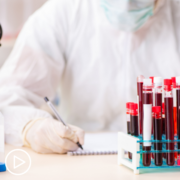Advances in the Treatment of Relapsed/Refractory Acute Myeloid Leukemia (AML)
Advances in the Treatment of Relapsed/Refractory Acute Myeloid Leukemia (AML) from Patient Empowerment Network on Vimeo.
AML expert Dr. Omer Jamy discusses his approach when considering treatment for patients with relapsed or refractory AML, including transplant eligibility, molecular markers, and whether clinical trials may be an appropriate option.
Dr. Omer Jamy is a Leukemia and Bone Marrow Transplant Physician and Assistant Professor at the University of Alabama at Birmingham. Learn more about Dr. Omer Jamy.
Related Resources:

What Is the AGILE Study? Research for AML Patients With the IDH1 Mutation |

|

Essential Testing Optimizing AML Care with Personalized Medicine |
Transcript:
Katherine Banwell:
Dr. Jamy, are there any recent advances that may affect the care of patients with relapsed or refractory AML?
Dr. Omer Jamy:
Yeah, that’s a good question. So, patients with relapse refractory AML, of course, carry a poor prognosis. That means that chemotherapy was working and has stopped working or chemotherapy didn’t work from the get-go, right?
So, in my practice I try to divide patients into two different buckets. One is that I need to get them into remission, and they’re fit for a transplant, so I take them to transplant.
So, then my treatment approach is a little different for those patients. As opposed to someone who’s elderly or too frail, that they may go into remission, but they may not be able to proceed to stem cell transplantation after that.
So, what happened in the relapsed/refractory setting also depends on what the patient received in the upfront setting. Ideally, I would recommend a clinical trial enrollment for patients with relapse refractory AML if they have access to it. At the time of relapsed/refractory AML, it is very important to again profile the leukemia to see if there are any mutations that were present at diagnosis or if there are any new mutations for which there may be targeted therapy. Some of those mutations for which we have targeted therapy include FLT3-ITD for which there is a drug called gilteritnib (Xospata), which is FDA-approved in the relapsed/refractory setting.
We spoke about IDH 1 which is ivosidenib, IDH 2 which is enasidenib (Idhifa) is also approved for patients with relapsed/refractory AML. And then more recently the FDA approved another IDH1 compound called olutasidenib (Rezlidhia) which is also for patients with relapse refractory acute myeloid leukemia with an IDH1 mutation. I think these are target therapies which have shown to get people into a second remission and beyond. And these have been approved in the last few years. And I think it is very important to basically test whether the person harbors these mutations so that we can target them accordingly.
For patients who don’t have any mutations we would generally, outside of a clinical trial, probably use the combination of some of the approved agents that may be venetoclax (Venclexta) with azacitidine (Vidaza) or decitabine (Dacogen). Patients who may have received this venetoclax or a hypomethylating agents frontline and may still be eligible for intensive chemotherapy.
You could offer them intensive chemotherapy in the relapsed/refractory setting, but I would say that at this point being at a center where there’s opportunities to enroll in a clinical trial would be really helpful as well.



